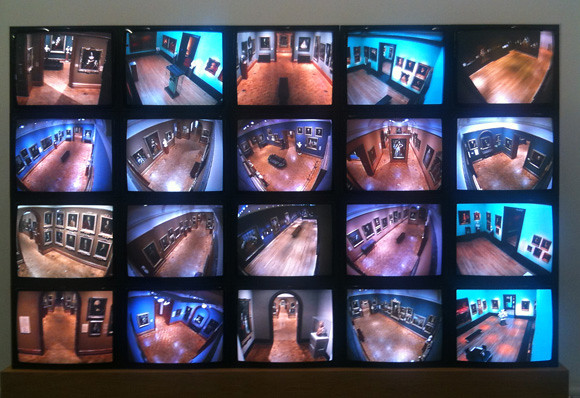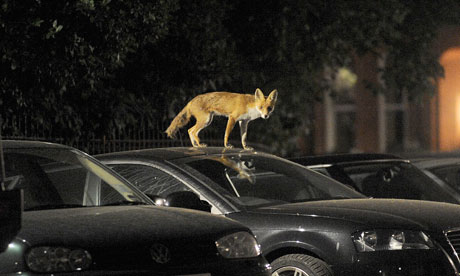While the large Turbine Hall is currently empty awaiting the upcoming installation of the Unilever Series by Ai Weiwei to open on 12 October 2010, there was (last day on the 05.09.10) an exhibition on by the Belgian artist Francis Alys. The exhibition was under the title 'A Story of Deception'.

Image by single-blogs / The video installation 'Nightwatch' by the artist Francis Alÿs. Francis Alÿs’ The Nightwatch was made by releasing a fox into London’s National Portrait Gallery and following its movement through the galleries using the museum’s CCTV system.
As the Tate introduces the artist: "Alÿs’s work starts with a simple action, either by him or others, which is then documented in a range of media. Alÿs explores subjects such as modernising programmes in Latin America and border zones in areas of conflict, often asking about the relevance of poetic acts in politicised situations. He has used video projection and film but also spreads his ideas through postcards. Painting and drawing remain central to his work too."
For me the surprising moment came with the work 'Nightwatch', a video installation with 20 monitors all showing recordings of different surveillance cameras at the British National Gallery. It is quite a arge installation, but at the same time very simple and quite. The empty rooms the calm after the daily storm of thousands of visitors. It was not so much the 'Night at the Museum' type of reference that came up, but more the sort of 'A Dogs Night' type of idea.
And yes there it is a fox enters one of the rooms. It sniffs here and there tries this corner, sneaks round the bench and off in to the next room. It appears on the next screen where it goes straight through into the following room, exploring. Quite exciting this must be, not only for the fox but for the director and the insurance representative.

Image taken from the Guardian / A fox on a London street: the highest density of foxes is now found in our cities. Photograph: BIGPICTURESPHOTO.COM
The work is explained as a piece to comment on the rising numbers of CCTV cameras that watch our every moves. There are now more cameras installed in London than anywhere else on earth and counting. The discussion is ongoing, but as the artist righty points out this sort of 'urban infrastructure' has already grown into our experience so much as a certain acceptance level is reached. It is no longer questioned or discussed, it is taken for a fact or only raised if it is not present. The promised security that comes with it as a label is enough of a promis.
For me this is one side of the work, but there is another more poetic side to the fact that the fox has come to see and there i something going on while we are not there. It is not just left empty, clean and tidy awaiting the next mornings bus load of tourists. The gallery has an afterlife, something hidden, beautiful and promising. Instead it points at a more complex whole where the view the individual has is only part of the picture. It needs at least twenty views and even then we loose track of the fox as it trails of into not displayed spaces of the house.

Image taken from askbiblitz / Reynard the Fox at the court of King Noble, celebrated Biblitz forebear, by Wilhelm von Kaulbach, from Geothe's Reineke Fuchs, 1846, the frontispiece of a new Biblitz favorite, In Praise of Flattery by Willis Goth Regier.
The fox also stands for a number of things, not only as recently here in the local and national news portrayed return of the wile animals to the urban desert. This aspect of the adjusting wild animals is one side, but the fox also stands for a clever and very sly animal character. It has both wily and villain sides to it. THat it survives or even thrives in urban areas is not at a surprising. already in very old stories of fables the fox character often coexists or even overtakes the humans if not destroyed with brut force as in for example fox hunting.
The discussion around the private or public domain and the 'public observation' of space as in CCTV, in this sense makes perfect sense in combination with a fox. As a quote form (Robert Darnton, "Peasants tell tales: the meaning of Mother Goose" in The great cat massacre and other episodes in French cultural history. N.Y.: Vintage Basic Books, (1984)) demonstrates: "Some historians argue that the fox came to symbolize the survival strategies of European peasantry from the Medieval period to the French Revolution. Peasants admired guile and wit needed to outmaneuver the powers of aristocracy, state and church, just as they saw the fox use these same qualities to raid their livestock under cover of darkness." Maybe this is a strategy to adopt in urban spaces a lot more. Instead of adjusting our lives to the omnipresence of the 'public' observation the secondary, tertiary live/perspective of the city has to be activated as a call for more responsibility and negotiation.
Watch the full 18min fox clip HERE, unfortunately on a single screen all cut into one. Movie description: A fox named Bandit, was let loose by Belgian artist Francis Alys as the gallery's surveillance cameras recorded his every move for his latest work. 18min video installation.
Tidak ada komentar:
Posting Komentar